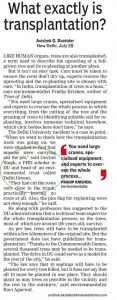
Avishek G Dastidar, New Delhi, July 29, 2008, Hindustan Times.
Transplantation, or re-planting a full-grown tree is no small task. One has to ensure that the roots don’t dry up; that the site where re-planting is be done is conducive to growth and that uprooting of the tree is done with utmost technical supervision. “In India, transplantation of trees is a hoax,” says environmentalist Pradip Krishen, author of Trees of Delhi.
“You need large cranes, specialised equipment, and experts to oversee the whole process in which everything, from the cutting of the tree and the pruning of the roots to identifying suitable soil for re-planting, involves immense technical knowhow, which civic bodies here don’t have,” he says.
 The Delhi University incident is a case in point. “When we went to check how the transplantation work was going on, we were shocked to find that masons were carrying out the job,” said Govind Singh, a PhD scholar in DU and head of an environmental trust called Delhi Greens. “They had cut the roots very close to the trunk, practically leaving no roots at all. Also, the pits dug for replanting were not deep enough,” he said.
The Delhi University incident is a case in point. “When we went to check how the transplantation work was going on, we were shocked to find that masons were carrying out the job,” said Govind Singh, a PhD scholar in DU and head of an environmental trust called Delhi Greens. “They had cut the roots very close to the trunk, practically leaving no roots at all. Also, the pits dug for replanting were not deep enough,” he said.
He along with professors has suggested to the DU administration that a technical team supervise the whole transplantation process so that the trees, most of which are around 100 years old, survive.
As per law, trees will have to be transplanted within a few kilometres of the original site. But the government does not have guidelines for transplantation. “Thanks to the Commonwealth Games, several thousand trees may be needed to be transplanted. The drive in DU could serve as a model for the rest of the city,” he said.
“The law says that 10 saplings will have to be planted for every tree felled, but it does not say that all 10 must be planted in one place. They should plant as may trees as possible in the vicinity and the rest in the outskirts,” said environmentalist Ravi Agarwal.
Some developers have already done that. Delhi Metro has developed a policy in which it plants a large number of the compensatory saplings around the original location.
Click here to read this news report on the HT’s website.
